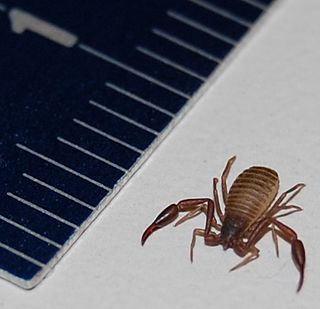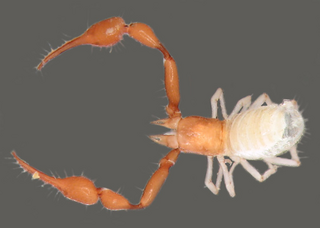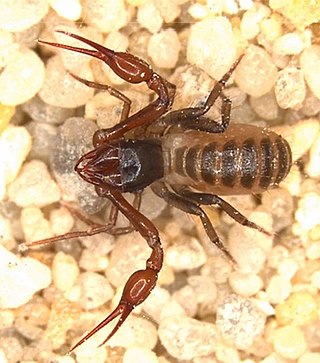
Lechytia is a genus of pseudoscorpions in the subfamily Lechytiinae within the family Chthoniidae. It is the sole genus in its subfamily and contains 22 described species from many parts of the world.

Chthoniidae is a family of pseudoscorpions within the superfamily Chthonioidea. The family contains more than 600 species in about 30 genera. Fossil species are known from Baltic, Dominican, and Burmese amber. Chthoniidae now includes the former families Tridenchthoniidae, and Lechytiidae which has been demoted to subfamilies.
Bochicidae is a family of pseudoscorpions distributed throughout the Americas from Texas and Mexico to South America, from the Antilles to Venezuela, Guyana and Brazil, as well as in Europe. Members of the family can be diagnosed mainly by features of the claws, notably the presence of exactly 12 trichobothria on each claw and a long, as opposed to short, venom duct. Some species live in caves while some are surface-dwelling.

Chernetidae is a family of pseudoscorpions, first described by Anton Menge in 1855.

Olpiidae is a family of pseudoscorpions in the superfamily Garypoidea. It contains the following genera:

Garypinidae is a family of pseudoscorpions, first described by Eugen von Daday in 1889.
Atemnidae is a family of pseudoscorpions, first described by Kyukichi Kishida in 1929.

Neobisiidae is a family of pseudoscorpions distributed throughout Africa, the Americas and Eurasia and consist of 748 species in 34 genera. Some species live in caves while some are surface-dwelling.

Garypus is a genus of pseudoscorpions in the family Garypidae. It was described by German arachnologist Ludwig Carl Christian Koch in 1873. The species are found mainly in tropical and subtropical areas, where they occupy supralittoral and littoral zones in seashore habitats.

Cheliferidae is a family of pseudoscorpions in the order Pseudoscorpiones, first described by Antoine Risso in 1827.

Syarinidae is a family of pseudoscorpions in the order Pseudoscorpiones. There are at least 20 genera and 110 described species in Syarinidae.
Ideoroncidae is a family of pseudoscorpions belonging to the order Pseudoscorpiones. Members of the family are known from Asia, Africa, western North America and South America.

Withiidae is a family of pseudoscorpions, first described by Joseph Conrad Chamberlin in 1931.
Lagynochthonius is a genus of pseudoscorpions in the family Chthoniidae. It was described in 1951 by Austrian arachnologist Max Beier.

Tyrannochthonius is a genus of pseudoscorpions in the family Chthoniidae. It was described in 1929 by American arachnologist Joseph Conrad Chamberlin.

Pseudotyrannochthonius is a genus of pseudoscorpions in the family Pseudotyrannochthoniidae. It was described in 1930 by Austrian arachnologist Max Beier.

Geogarypus is a genus of pseudoscorpions in the Geogarypidae family. It was described in 1930 by American arachnologist Joseph Conrad Chamberlin. The genus has a cosmopolitan distribution.
Americhernes is a genus of pseudoscorpions in the Chernetidae family. It was described in 1976 by American arachnologist William Muchmore.
Paraliochthonius is a genus of pseudoscorpions in the Chthoniidae family. It was described in 1956 by Austrian arachnologist Max Beier.












